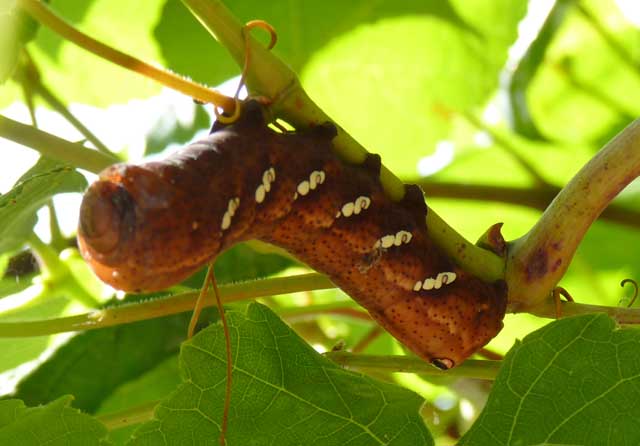Sphinginae subfamily
Sphingini tribe:
 |
Agrius cingulata,
WO, Pink-spotted Hawkmoth:
Larvae: Convolvulaceae family, especially
Ipomoea batatas (sweet potato); Solanaceae family,
especially (Datura) (jimsonweed) related plants in
Americas. Also brown form. Look for very large, dark
spiracular circles.
|
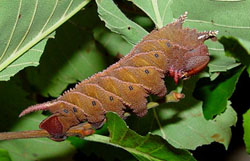 |
Ceratomia amyntor
WO,
Elm Sphinx/Four-horned Sphinx
Larvae: Elm (Ulmus), birch (Betula), basswood
(Tilia), cherry (Prunus).
Both green and brown forms. Four horns near head are diagnostic.
|
 |
Ceratomia catalpae
WO,
Catalpa Sphinx
Young larvae feed gregariously on Catalpa species
(Catalpa bignoniodes and C. speciosa) in
Bignoniaceae family, skeletonizing foliage.
Larvae: mostly white in early instars.
|
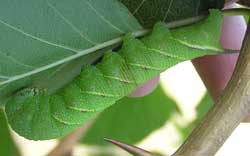 |
Ceratomia hageni
WO, Hagen's Sphinx/Osage Orange Sphinx
Larvae: osage orange (Maclura pomifera), granulous appearance with variable amounts of purple
along oblique white stripes.
|
 |
Ceratomia undulosa
WO, Waved
Sphinx
Fraxinus, Ligustrum, Quercus, Crataegus and
Chionanthus virginicus are listed as hosts.
In fifth instar, spiracular ovals decidedly red &
anal horn is off-white to pinkish laterally.
|
 |
Dolba hyloeus
WO, Pawpaw Sphinx
Larvae: pawpaw (Asimina triloba), littleleaf sweetfern
(Myrica aspleniifolia), possum haw (Ilex decidua),
inkberry (Ilex glabra); Tall Gallberry Holly
(Ilex coriacea).
Louis Handfield reports larvae probably feed on Ilex verticellata
in Quebec.
|
 |
Lapara coniferarum
WO, Southern Pine Sphinx:
Larvae: various pine species, including loblolly pine
(Pinus taeda) & longleaf pine (P. pinaster). Well
camouflaged and are without an anal horn.
|
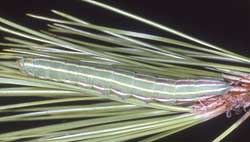 |
Lapara phaeobrachycerous
WO, Gulf Pine Sphinx
Larvae probably feed upon various pine species, including loblolly pine (Pinus taeda) & longleaf pine (Pinus pinaster).
|
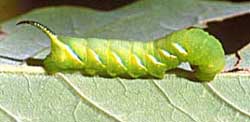 |
Manduca jasminearum
WO, Ash Sphinx
Larvae feed on ash in the Fraxinus genus. Syringa and Ulmus have
also been reported.
Note the black anal horn.
|
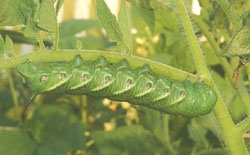 |
Manduca quinquemaculatus
WO,
Five-spotted Hawkmoth
Caterpillars called Tomato Hornworms; black horn at end of abdomen.
Larvae: potato, tobacco, tomato, other plants in
nightshade family (Solanaceae).
|
 |
Manduca rustica
WO, Rustic Sphinx:
Numerous white nodules atop thorax,
seven pairs of oblique, blue-gray stripes along body side.
Horn white base & blue-gray tip. Many hosts.
|
 |
Manduca sexta
BAMONA, Carolina Sphinx
Tobacco Hornworms, equipped with red-tipped horn at end of
abdomen, true gluttons, feed on tobacco, tomato, &
occasionally potato & pepper crops & other plants in &
nightshade family (Solanaceae).
|
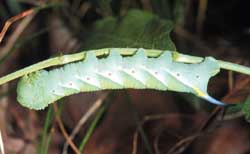 |
Paratrea plebeja
WO, Plebeian Sphinx
Common trumpetcreeper (Campsis radicans),
Florida yellow-trumpet (Tecoma stans), lilac
(Syringa species),
passionflower (Passiflora species).
Anal horn blue, preceded by yellow dash.
|
 |
Sphinx drupiferarum
WO,
Wild Cherry Sphinx
Larvae hide in day, feed primarily on cherry, plum, apple
at night. Amelanchier nantuckensis
in Massachusetts,d have been reared to pupation in Michigan on
Prunus serotina. Note purple oblique lines.
|
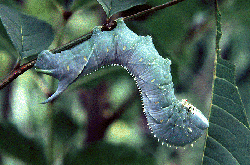 |
Sphinx franckii
WO, Franck's Sphinx Moth
Larvae feed exclusively on various species of ash (Fraxinus).
Raised, pointed bumps, especially near head & thorax give this
larva reptilian appearance.
|
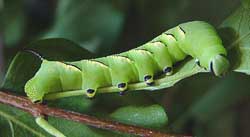 |
Sphinx kalmiae
WO, Laurel Sphinx
In final instar, black on head, lateral lines, horn and on abdominal
legs is diagnostic. Lilac and fringe.
|
Smerinthini Tribe:
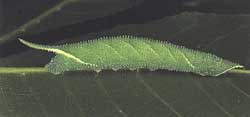 |
Amorpha juglandis
WO,
Walnut Sphinx
Walnut & butternut (Juglans),
hickory (Carya), alder (Alnus), beech (Fagus),
hazelnut (Corylus), hop-hornbeam (Ostrya).
|
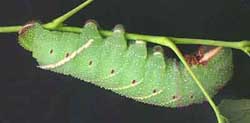 |
Pachysphinx modesta
WO,
Modest Sphinx/Poplar Sphinx
Larvae feed on poplars, cottonwood. Anal horn greatly reduced in final instar.
|
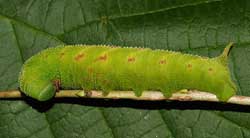 |
Paonias astylus
WO, Huckleberry Sphinx
March-September in Florida & from April-September in Louisiana. One brood northward from
June-August. Blueberry; huckleberry; cherry, willow.
Uncommon species.
|
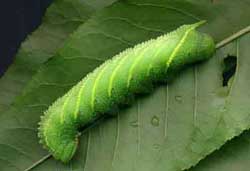 |
Paonias excaecata
WO,
the Blinded Sphinx
Willows, birches, cherries.
I have also found them in the wild on oak in eastern Canada.
Skin very granulose.
|
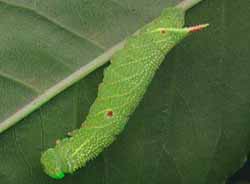 |
Paonias myops
WO, Small-eyed Sphinx
The larvae depicted is probably third instar.
There may be more red spotting on the sides
as larvae mature.
|
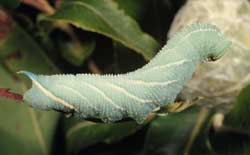 |
Smerinthus jamaicensis
WO,
Twin-spotted Sphinx
Many forest trees including birches & cherries,
especially fond of poplars & willows. Red markings on sides
vary greatly from specimen to specimen.
|
Macroglossinae subfamily
Dilophonotini tribe:
 |
Hemaris diffinis
BAMONA,
Snowberry Clearwing/Bumblebee Moth
Snowberry (Symphoricarpos),
honeysuckle (Lonicera), Coralberry, viburnums, Blue Dogbane
(Apocynum); dwarf bush honeysuckle (Diervilla lonicera).
Horn black with yellow base.
|
 |
Hemaris thysbe
BAMONA, Hummingbird Clearwing
orangey-pink prepupal form. Lateral line runs
from S1 to blue horn.
Hemaris thysbe larvae feed on viburnum and related plants.
|
Philampelini tribe:
 |
Eumorpha achemon
CLRw,
Achemon Sphinx:
Grape (Vitis), Virginia Creeper
(Parthenocissus quinquefolia) & other vines & ivies
(Ampelopsis).
Light (green) form, a reddish-orange form, & darker (tan/brown)
form. Note six "segmented" oblique lines.
|
Eumorpha achemon, Huntsville, October 7, 2012, Chris, Lyn and Riley Watson
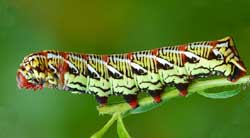 |
Eumorpha fasciatus
WO, Banded Sphinx:
primrose-willow, Ludwigia (water primrose)
other plants in evening primrose family. Hornless larva
highly variable. Large, dark spiracular circles & dark
line in center of back.
|
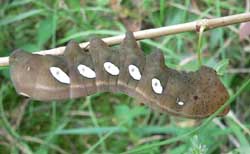 |
Eumorpha pandorus
BAMONA, Pandorus Sphinx
If you have Grape or Virginia Creeper nearby, then you might encounter
this species.Note e five large white ovals. Orangey-brown & green
forms also.
|
Macroglossini tribe:
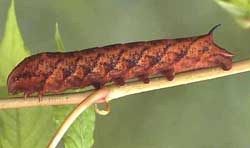 |
Amphion floridensis
WO,
Nessus Sphinix
Vitis),
ampelopsis (Ampelopsis); cayenne pepper (Capsicum).
Larvae green until final instar.
|
 |
Darapsa choerilus
WO, Azalea Sphinx
Larvae: Azalea, Viburnum, progress very rapidly.
Larva to left on Viburnum cassinoides is getting ready to
pupate. Color change from green to light burgundy-brown indicates
imminent pupation.
|
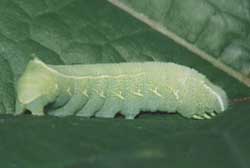 |
Darapsa myron
WO, Virginia Creeper Sphinx/Grapevine Sphinx
If you have
foodplants indicated in common names, you probably have this
species nearby. Lower wings orange.
Larvae: Virginia creeper (Parthenocissus quinquefolia),
Grape (Vitis), Ampelopsis, Viburnum.
|
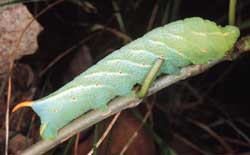 |
Darapsa versicolor
WO,
Hydrangea Sphinx:
Larvae turn deep chocolate brown just prior to pupation,
"horn" on tail also turns downward as pupation draws near.
Larvae:Smooth hydrangea
(Hydrangea arborescens), buttonbush
(Cephalanthus occidentalis), waterwillow
(Decodon verticillatus).
|
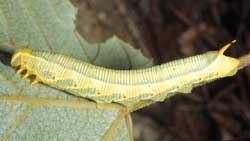 |
Deidamia inscriptum
WO,
the Lettered Sphinx
Grape (Vitis), ampelopsis (Ampelopsis), &
Virginia creeper (Parthenocissus).
Alternating yellow & greyish-green rings across back
distinguish this larva.
|
 |
Hyles lineata
WO, White-lined Sphinx:
Larvae: highly varied; feed on great diversity of plants
including willow weed (Epilobium), four o'clock (Mirabilis),
apple (Malus), evening primrose (Oenothera), elm
(Ulmus), grape (Vitis), tomato (Lycopersicon),
purslane (Portulaca), Fuschia.
All larvae seem, however, to have red/black swellings split by
dorso-lateral lines.
|
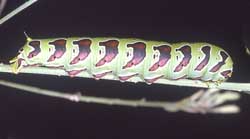 |
Proserpinus guarae
WO,
Proud Sphinx
Larvae: (Onagraceae) including evening primrose
(Oenothera), gaura (Gaura), & willow weed
(Epilobium).
rare
|
 |
Sphecodina abbottii
WO,
Abbott's Sphinx:
Larvae feed at night on grape (Vitis) & ampelopsis
(Ampelopsis), hide on bark during
day. Virginia creeper would also suitable host. Dark form
without green patches. Note "raised eye", replacing anal horn.
|
 |
Xylophanes tersa
WO,
Tersa Sphinx:
Larvae: Borreria, Catalpa, Manettia spp.,
Smooth buttonplant (Spermacoce glabra), starclusters
(Pentas species). Also recorded on joe-pie weed &
Hamelia patens & Hedoydis nigricans. The green form may be more
common.
|
|
|
